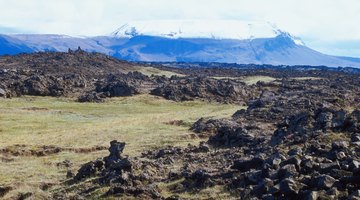How to Remove a Lava Rock Fireplace
As the name implies, lava rock is literally a volcanic building material rock. Lava rock is a common feature of many 1970s-era homes but the dated look and demanding maintenance -- it is a notorious dust and smoke-stain magnet -- of the stone for the most part negates its residential construction use today.

If you have a lava rock fireplace that's in serious need of upgrading, the good news is that the stone is relatively easy to remove. The bad news is that regardless of what you do, the process is extremely messy.
Things You Will Need
- Leather gloves
- Eye protection
- Breathing protection
- Painter’s plastic
- Blue tape
- Tarps
- Dumpster rental
- Small sledgehammer
- Masonry chisel
- Crowbar
- Utility knife
- Wall mud
- Tin snips
Tip
Although it is messier, lava rock removal involves the same techniques as tile removal.
Warning
Wear leather gloves, eye protection and breathing protection while removing lava rock.
-
Remove the fireplace insert, if applicable. Drape painter's plastic over furniture. Cover nearby furniture with plastic. Cordon off the fireplace to disallow demolition dust from traveling through your house. Drape painter's plastic from the ceiling. Tape it to the ceiling with blue tape.
-
Surround and seal off the entire fireplace. Leave a man-sized open area in the draped plastic for entering and exiting the work area. Lay a tarp on the floor for collecting debris. Lay down a tarp in your garage or yard to collect debris or rent a dumpster that you can toss the lava rock into.
-
Use a small sledgehammer and masonry chisel to remove the lava rock. Do not use an electric chipping hammer as the tool may puncture the substrate. Begin by hammering the chisel under the edge of a single lava rock piece. Begin in the middle of the wall. Flake away the piece until the substrate is exposed. Collect debris and sediment on the tarp below the fireplace.
-
Continue the same technique described above for removing adjoining pieces. Make sure that you get a good bite under the stone with the chisel; in many cases, you can pry the lava rock away from the wall. This saves the do-it-yourselfer time because the pieces come off the wall in larger chunks and are easier to transport to the dumpster or trash pile. Carry out the debris to the dumpster or tarp before the pile becomes unmanageable.
-
Use a crowbar for stubborn pieces. Pry the crowbar under a piece and gradually increase pressure. Use a ladder to reach high areas. Use a utility knife to break the bond at lava rock-drywall intersections. Run the knife along the drywall-lava rock seam to keep the drywall from being torn during lava rock removal.
-
Finish the lava rock removal by removing the fireplace hearth. Begin by prying the crowbar under the center hearth piece. Place upward pressure on the crowbar. Wait for a pop sound to confirm that the hearth stone-substrate bond is broken. Remove and discard additional hearth pieces.
-
Repair the mortar substrate. If you are retiling the fireplace or cladding it with new stone, fill holes or voids in the mortar-wire-mesh layers. Purchase wall mud -- 3/1/1, sand, cement, lime -- for doing this. Smooth out rough patches by adding mortar. If you plan on re-drywalling the fireplace area, remove the substrate down to the wall studs. Pry under the metal lath with the crowbar. Use tin snips to cut back large areas of mortar-covered wire mesh. Dispose of the mortar and mesh in the designated area.
The Drip Cap
- As the name implies, lava rock is literally a volcanic building material rock.
- If you have a lava rock fireplace that's in serious need of upgrading, the good news is that the stone is relatively easy to remove.
- Drape painter's plastic from the ceiling.
- Carry out the debris to the dumpster or tarp before the pile becomes unmanageable.
- Use a crowbar for stubborn pieces.
- Use a utility knife to break the bond at lava rock-drywall intersections.
- Remove and discard additional hearth pieces.
- If you plan on re-drywalling the fireplace area, remove the substrate down to the wall studs.
Resources
Writer Bio
Residing in San Diego, Calif., Tim Daniel is a professional writer specializing in politics. His work has appeared at both the Daily Caller and Pajamas Media. With more than 20 years of experience in the field of construction, Daniel also specializes in writing about tile, stone and construction management. He is pursuing a bachelor's degree in communications.
Photo Credits
- Jupiterimages/Photos.com/Getty Images
- Jupiterimages/Photos.com/Getty Images
More Articles



